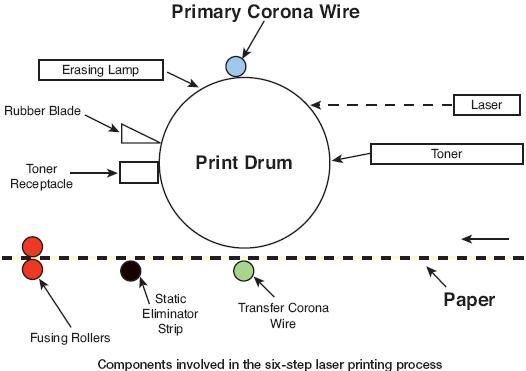The drum is at the center of the whole printing process:

Course list http://www.c-jump.com/bcc/
Older printers connect to parallel ports.
Note that devices connecting to parallel, serial, and SCSI ports require the computer to be shut down while the device is connected or disconnected.
Many printers connect via USB ports.
Network printers connect directly to network.
Network printers usually have standard RJ45 connectors and network cards built into the printer.
Some SOHO routers offer capabilities of printer servers:
Printer connects to a designated USB port on the router.
The client computers install special client software configured to communicate with the printer server.
Laser Printer is the most common type of printers in businesses.
Injet Printers are prevalent at homes.
Produce high-quality text and graphics
Most print in black and white, more expensive can print in colors.
There is a laser beam inside.
The laser projects the image to be printed onto an electrically charged drum.
The image is transferred from the drum to the paper.
Electrically charged toner powder is used to produce the image.
The toner comes from a replaceable toner carttridge.
The drum is at the center of the whole printing process:

As the drum spins...
A rubber blade removes excess toner from the drum.
An erasing lamp removes any leftover charge, bringing the drum charge to zero volts.
The conditioning is also known as charging.
A negative charge is applied to the drum by the primary corona wire.
The primary corona wire is powered by a high-voltage power supply.
The writing is also known as exposing.
The laser is activated and writes to the drum while the drum spins.
The center of the drum is grounded.
The result of the laser beam hitting the drum is the negative charge dissipating toward the center of the drum.
Laser-written areas of the drum have a lesser negative charge.
The toner from the cartridge has higher electric charge than the written areas of the drum.
The toner is applied as it becomes attracted to the drum surface with lesser charge.
The toner on the drum resembles the original printable image.
The paper slides between the drum and a positively charged corona wire.
Positively charged corona wire is known as transfer corona wire.
The paper itself gets a lot of positive charge.
The toner is transferred to the paper as the drum rolls over it, because opposite charges attract the toner particles to the paper.
The paper than passes over the static elimination device (static elimination strip.)
The static elimination strip removes excess charge from the paper to prevent any further attraction of dust to the paper.
The paper passes through the fusing assembly.
The fusing assembly contains pressurized rollers and the heating element.
The heating element reaches approximately 400 degrees F (about 200 degrees C.)
Speed: 10 to 100 pages per minute
Print Quality: common quality is 600 DPI (dots per inch)
Such level of quality is considered to be letter quality.
Printers capable of 1200 DPI and higher are also available.
Printer priority can be set via Advanced tab of the Printer Properties Page.
The priority is in the range 1-99; 99 being the highest.
This is useful when two or more network printers combine a network pool.
Each printer can be given a different priority.
Usually one printer is set to be run at a higher priority.
When a printing job goes directly to the printer, its success relies on the amount of memory inside the printer.
Just like regular PCs, laser printers allow to add more physical memory to the device.
To eliminate dependency on the amount of RAM in the printer, a job spooling technique is used.
The sooling is controlled by the Print Spooler service.
At the command prompt, the following two commands can be used to start and stop the Spooler service:
net start spooler
net stop spooler
Note: on Vista and Windows 7 these commands require Administrator's privilege.
Start Printing Immediately:
One page at a time is soopled to the hard drive.
Once spooled, the page is sent to the printer.
The process repeats for every page in the document.
Note: Start Printing Immediately is a default option on Windows and usually is the best option for printing.
Start Printing After Last Page is Spooled:
Entire document is spooled to the hard drive, page by page.
Each page is then sent to the printer.
This is usually slower, but creates less issues related to printer-related failures.
Under the hood, Windows XP uses Enhanced Metafile files with EMF extension.
The EMF file contains graphics language for printer drivers.
EMF files are part of Windows Metafile (WMF) family. There are also compressed versions of Windows Metafiles known as Compressed Windows Metafile (WMZ) and Compressed Windows Enhanced Metafile (EMZ).
Windows Vista and 7 use Microsoft XPS Document Writer, which can be opened via
Start -> Control Panel -> Printers.
The XPS Document Writer creates Open XML Paper Specification file that has XPS extension.
Paper jams:
Turn printer off and then on -- the printer may clear the problem on its own. This is known as power cycling the printer.
Remove and inspect the paper tray.
Sometimes laser printer fusing assembly overheats and simply needs time for cooling.
Blank paper:
Empty toner cartridge, install a new one.
Tone cartridge installed without the sealing tape removed.
Transfer corona wire has failed and needs replacement.
Lines/Smearing:
Scratch on the printer drum
Dirty primary corona wire
Vertical lines on paper indicate that some debree has stuck to the drum
In the worst case scenario, the fusing assembly may have failed.
Garbage printout:
Incorrect printer driver
"Ghosts" on the printout:
Failing drum or fusing assembly
Printer error codes:
Read the printer manual (most available online) for reference and recommended solutions.
Printer connectivity problems:
Check physical connection
Ping network printer IP address. Also, most laser printers have an LCD display which displays the network configuration screen.
If printer is connected to the local computer, verify the printer driver.